+Search query
-Structure paper
| Title | Molecular basis of plastoquinone reduction in plant cytochrome bf. |
|---|---|
| Journal, issue, pages | Nat Plants, Vol. 10, Issue 11, Page 1814-1825, Year 2024 |
| Publish date | Oct 3, 2024 |
 Authors Authors | Sebastian Pintscher / Rafał Pietras / Bohun Mielecki / Mateusz Szwalec / Anna Wójcik-Augustyn / Paulina Indyka / Michał Rawski / Łukasz Koziej / Marcin Jaciuk / Grzegorz Ważny / Sebastian Glatt / Artur Osyczka /   |
| PubMed Abstract | A multi-subunit enzyme, cytochrome bf (cytbf), provides the crucial link between photosystems I and II in the photosynthetic membranes of higher plants, transferring electrons between plastoquinone ...A multi-subunit enzyme, cytochrome bf (cytbf), provides the crucial link between photosystems I and II in the photosynthetic membranes of higher plants, transferring electrons between plastoquinone (PQ) and plastocyanin. The atomic structure of cytbf is known, but its detailed catalytic mechanism remains elusive. Here we present cryogenic electron microscopy structures of spinach cytbf at 1.9 Å and 2.2 Å resolution, revealing an unexpected orientation of the substrate PQ in the haem ligand niche that forms the PQ reduction site (Q). PQ, unlike Q inhibitors, is not in direct contact with the haem. Instead, a water molecule is coordinated by one of the carbonyl groups of PQ and can act as the immediate proton donor for PQ. In addition, we identify water channels that connect Q with the aqueous exterior of the enzyme, suggesting that the binding of PQ in Q displaces water through these channels. The structures confirm large movements of the head domain of the iron-sulfur protein (ISP-HD) towards and away from the plastoquinol oxidation site (Q) and define the unique position of ISP-HD when a Q inhibitor (2,5-dibromo-3-methyl-6-isopropylbenzoquinone) is bound. This work identifies key conformational states of cytbf, highlights fundamental differences between substrates and inhibitors and proposes a quinone-water exchange mechanism. |
 External links External links |  Nat Plants / Nat Plants /  PubMed:39362993 / PubMed:39362993 /  PubMed Central PubMed Central |
| Methods | EM (single particle) |
| Resolution | 1.94 - 2.33 Å |
| Structure data | EMDB-19938, PDB-9es7: EMDB-19939, PDB-9es8: EMDB-19940, PDB-9es9: |
| Chemicals |  ChemComp-HEM: 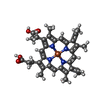 ChemComp-HEC: 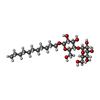 ChemComp-UMQ:  ChemComp-LMG:  ChemComp-CLA:  ChemComp-SQD: 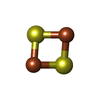 ChemComp-FES:  ChemComp-BCR:  ChemComp-HOH: 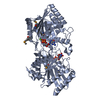 PDB-1h65: 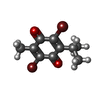 ChemComp-BNT: |
| Source |
|
 Keywords Keywords | OXIDOREDUCTASE / b6f complex / photosynthesis / membrane protein / electron transport / proton transport / quinone catalysis / water channels / inhibitor |
 Movie
Movie Controller
Controller Structure viewers
Structure viewers About Yorodumi Papers
About Yorodumi Papers




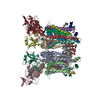

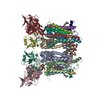

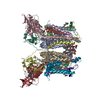
 spinacia oleracea (spinach)
spinacia oleracea (spinach)